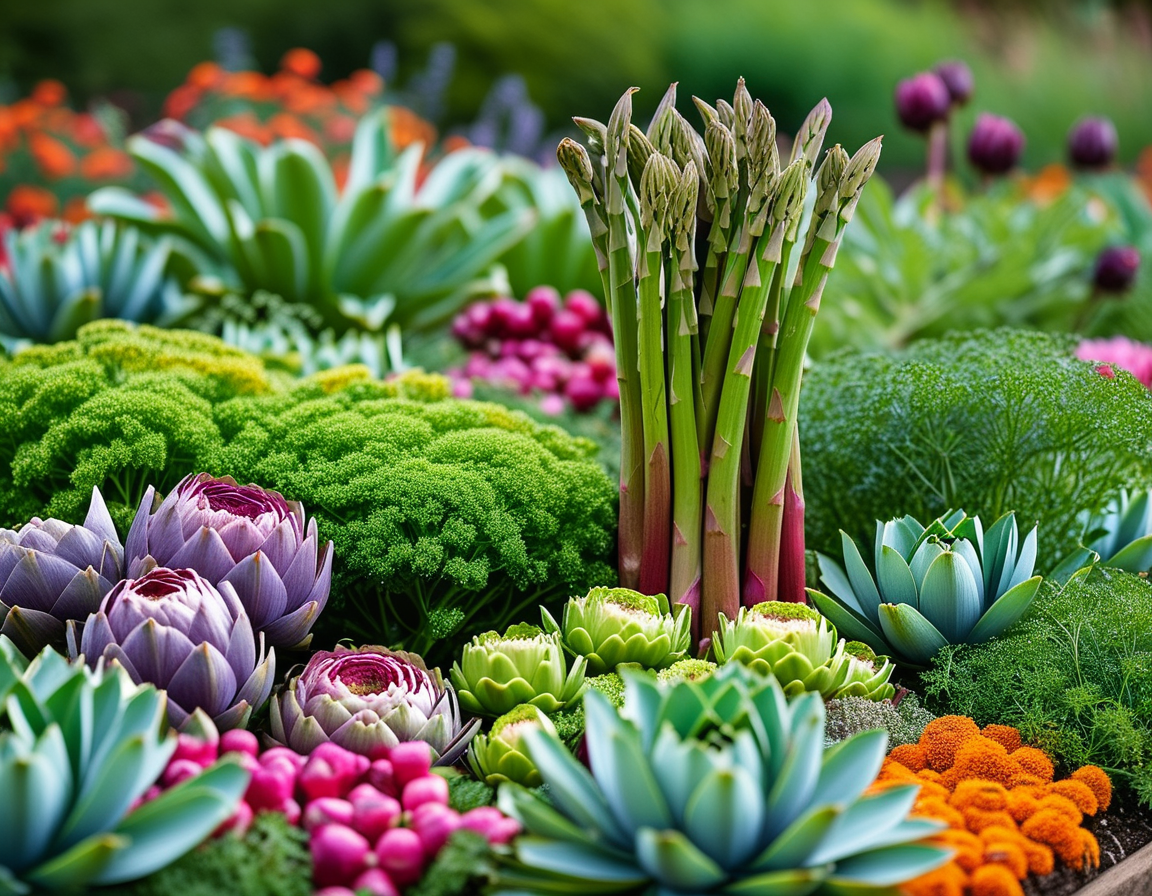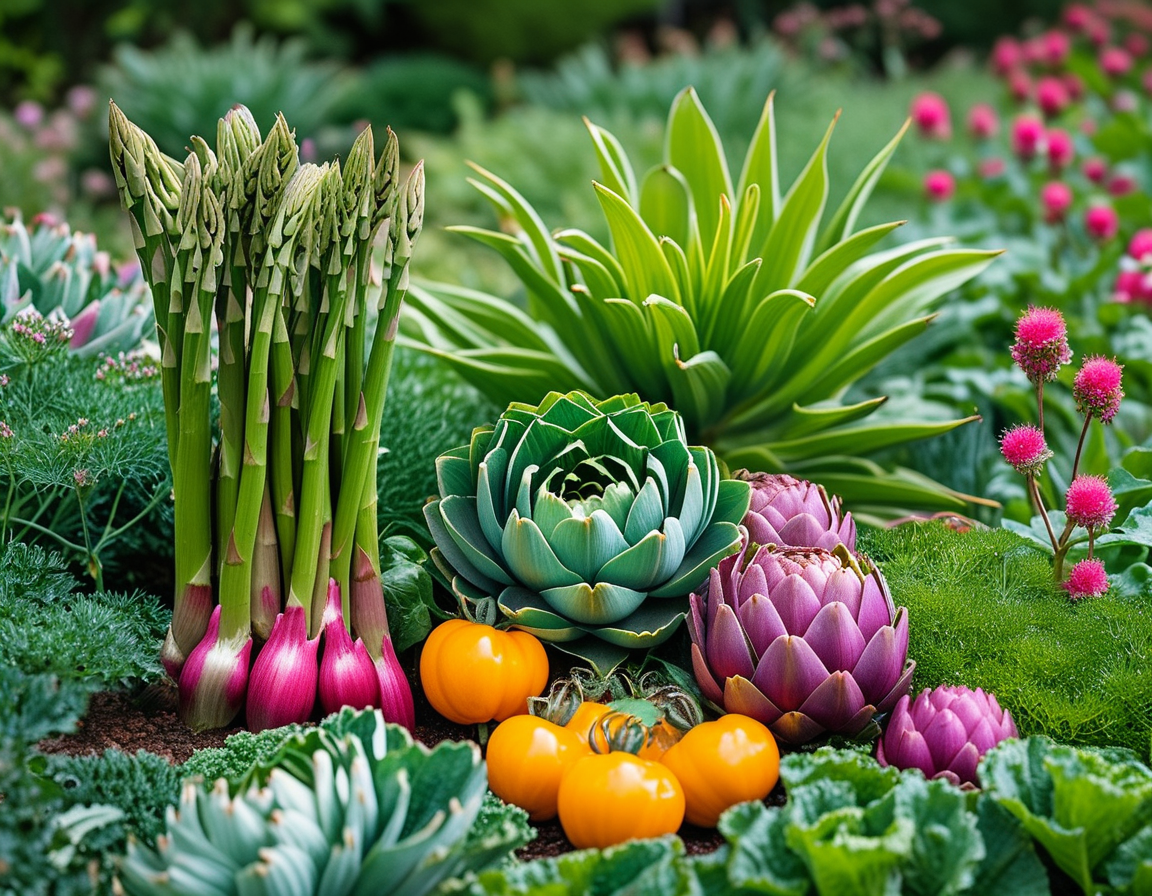Asparagus: The Long-Term Investment
Asparagus is a garden staple. Once established, an asparagus bed can yield tasty spears for over 20 years. Imagine walking into your garden each spring, knowing those tender green shoots are waiting for you. It’s not just a vegetable; it’s a relationship with time.
Planting asparagus doesn’t require as much effort as many think. It thrives in full sun and well-drained soil. After a couple of years, it rewards your patience with a spring harvest that bursts with flavor. Whether steamed, grilled, or roasted, asparagus quickly becomes a highlight of any dish.

And there’s something rewarding about growing your own food. It’s hard to describe but deeply satisfying. Watching a plant grow from a seedling to a productive crop connects us to nature in a beautiful way.
Rhubarb: The Tart Wonder
Rhubarb captivates with its vibrant red stalks. It’s a hardy perennial that doesn’t just survive; it thrives. Particularly in cool climates, rhubarb stands out in spring gardens. Many cherish its tartness, perfect for pies, jams, and sauces. But it’s more than just a cooking ingredient; it’s nostalgia on a plate.
It’s not unusual to reminisce about the scent of rhubarb simmering in sugar. That unmistakable aroma wafts through the house. For many, that’s the sound of childhood. Gardening becomes a way of preserving these memories, linking us to our past.

But beware, rhubarb’s leaves are toxic. This raises the question: how well do we educate ourselves about plants? Knowing what’s edible and what isn’t is vital in gardening. An empowered gardener is a successful gardener.
Artichoke: The Gourmet Choice
Artichokes may seem fancy. But they’re surprisingly easy to grow. These perennial beauties don’t just look good; they offer a chance to delve into gourmet cooking. Those edible buds are delicious, bringing an elegant touch to any meal. What’s not to love?
In the heart of summer, imagine inviting friends over to share an artichoke feast. The first bite is tender and buttery, a true taste of indulgence. You might find, as I have, that food tastes better when you’ve grown it yourself. There’s joy in sharing that experience.

Moreover, artichokes boast an impressive profile on the plate. They’re a conversation starter, a delightful centerpiece. And once you’ve harvested your first buds, this culinary gem inspires you to try out new recipes, transforming your kitchen into a test lab for flavors.
Horseradish: The Spicy Perennial
If you’re seeking a punch of flavor, horseradish is the answer. This vigorous root vegetable adds zing to any dish while being relatively low maintenance. But let’s be honest, it’s not for the faint of heart. Its strong taste can pack a serious punch.
Plant within a dedicated space; horseradish can spread. This aggressive grower thrives in various conditions. However, preparing your garden for horseradish means you’re welcoming heat. Do you enjoy the thrill of growing something bold?
Consider the thrill of crafting homemade sauces that elevate your cooking. Each grated root unlocks a world of flavors. It transforms ordinary meals into extraordinary experiences, encouraging creativity in the kitchen.
Jerusalem Artichoke: A Unique Delight
Often underestimated, Jerusalem artichokes are gems in the garden. Known as sunchokes, these tubers are crunchy and nutty. Anyone can grow them, but they’re sneaky growers. Invasive and resilient, they can take over if not contained. The question lies in how we approach our gardening plans.
Planting them is simple, but the rewards are worthwhile. They can be harvested from late summer through fall. Their delicious versatility means they can be added to soups, salads, or roasted. The best part? Once planted, they offer a near-endless supply of crispy tubers.
Sunchokes encourage you to think creatively. Try different cooking methods and culinary styles. They awaken the hidden chef in us, reminding us of the joys of experimentation.
Lovage: The Celery-Like Herb
Lovage isn’t as commonly known but deserves more attention. This perennial herb has a flavor reminiscent of celery. Easy to grow, it enriches numerous dishes, from soups to salads. Are you looking for that hint of freshness in your meals?
Growing lovage allows for continuous harvesting. Its leafy greens add delightful flavor. Many casual cooks may overlook it, but those who recognize its potential find it indispensable in their kitchens.
In my own experience, lovage enhances flavors without overshadowing them. Its subtle notes can bridge the gap between bold and delicate dishes. And that’s what cooking is all about—finding harmony on the plate.
Walking Onion: The Self-Propagating Wonder
Walking onions, or tree onions, bring a fascinating twist to the gardening world. These unique perennials produce bulbs that “walk” around your garden. Continuous harvesting becomes a reality with these resilient plants. What an unusual yet rewarding experience it is!
Their charm lies not only in their hardiness. The flavor is sharper than traditional green onions. Imagine the surprise of guests upon tasting an unexpectedly delicious garnish. You grow them with minimum fuss, enhancing meals in a one-of-a-kind way.
These onions embody the spirit of abundance. They represent what it means to cultivate ongoing nourishment from your own garden. What else could you ask for in a companion plant?
Sorrel: Tangy and Fresh
Sorrel is distinguished by its tangy flavor that can brighten any dish. Its tender leaves invite harvesting throughout the growing season. It begs the question: how do we incorporate seasonal flavors into our cooking?
Using sorrel provides a light, zesty kick. It pairs well with salads, giving them a refreshing twist. Each bite offers a burst of flavor reminiscent of bright summer afternoons, full of possibilities.
Incorporating sorrel into my meals reminds me that cooking is seasonal. It reflects an ever-changing landscape of ingredients. Building a rapport with seasonal produce is part of the joy of gardening.
Chinese Artichoke: The Knobby Tubers
The Chinese artichoke, or crosnes, brings a unique perspective. These knobby, small tubers offer a crunchy texture and nutty flavor. Shying away from conventional gardening advice can yield delightful surprises. Are we open to trying something new?
Their small size means they can be added to various dishes, from stir-fries to fancier presentations. The crunch adds intrigue, elevating meals to something special. It’s exciting to see how little ingredients can transform favorites into truly memorable experiences.
Gardening this way is about discovery. With crosnes, you foster curiosity. You learn to embrace the quirks and intricacies of unique plant life.
Good King Henry: The Traditional Choice
Good King Henry is an unsung hero in the world of perennial vegetables. With tender shoots and edible leaves, it holds its own in any garden. This plant doesn’t just grow; it flourishes, offering continuous harvests as the seasons change.
Growing this plant reflects a commitment to tradition. It connects us to our roots, quite literally. Its persistence is a testament to the resilience of old-world gardening practices.
Incorporating Good King Henry into your kitchen reflects a deep appreciation for edible plants that are often overlooked. Isn’t it thrilling to champion such underrated treasures?
Sea Kale: Coastal Excellence
Sea kale thrives near the ocean, boasting a mild, nutty flavor. From coastal areas, this perennial requires little maintenance once established. Growing it feels like a nod to culinary history, almost as if it brings the sea to your table.
Its sassy resilience fits perfectly into gardens craving unique flavor profiles. How often do we reflect on the stories our plants tell? Gardens narrate tales of perseverance, adaptation, and growth, providing lessons that extend beyond the plate.
Harvesting sea kale connects us to the rhythm of nature. Each bite is a reminder that food isn’t just functional; it’s personal and tied to our environment.
Perennial Kale: Year-Round Harvest
Perennial kale introduces a new dimension to year-round gardening. Reinforced against cold climates, it continuously offers lush greens. How incredible is it to think about a garden that doesn’t lie dormant?
Rich in nutrition, perennial kale fuels an appreciation for healthy eating. It invites creativity when preparing meals, giving cooks the tools to inspire both themselves and others. Every salad or smoothie becomes a celebration of the season.
Moreover, the thrill of having leafy greens ready for winter dishes is unparalleled. With every bite, we’re reminded of what’s possible year-round. Growing your own food encourages you to forge connections with your meals, promoting a sense of fulfillment.
In a world increasingly focused on sustainability, these perennial vegetables represent hope. They invite us to rethink our gardening practices. What’s truly possible when we choose plants that keep giving back? The journey through perennial gardening is laden with lessons and flavors for all to explore.




